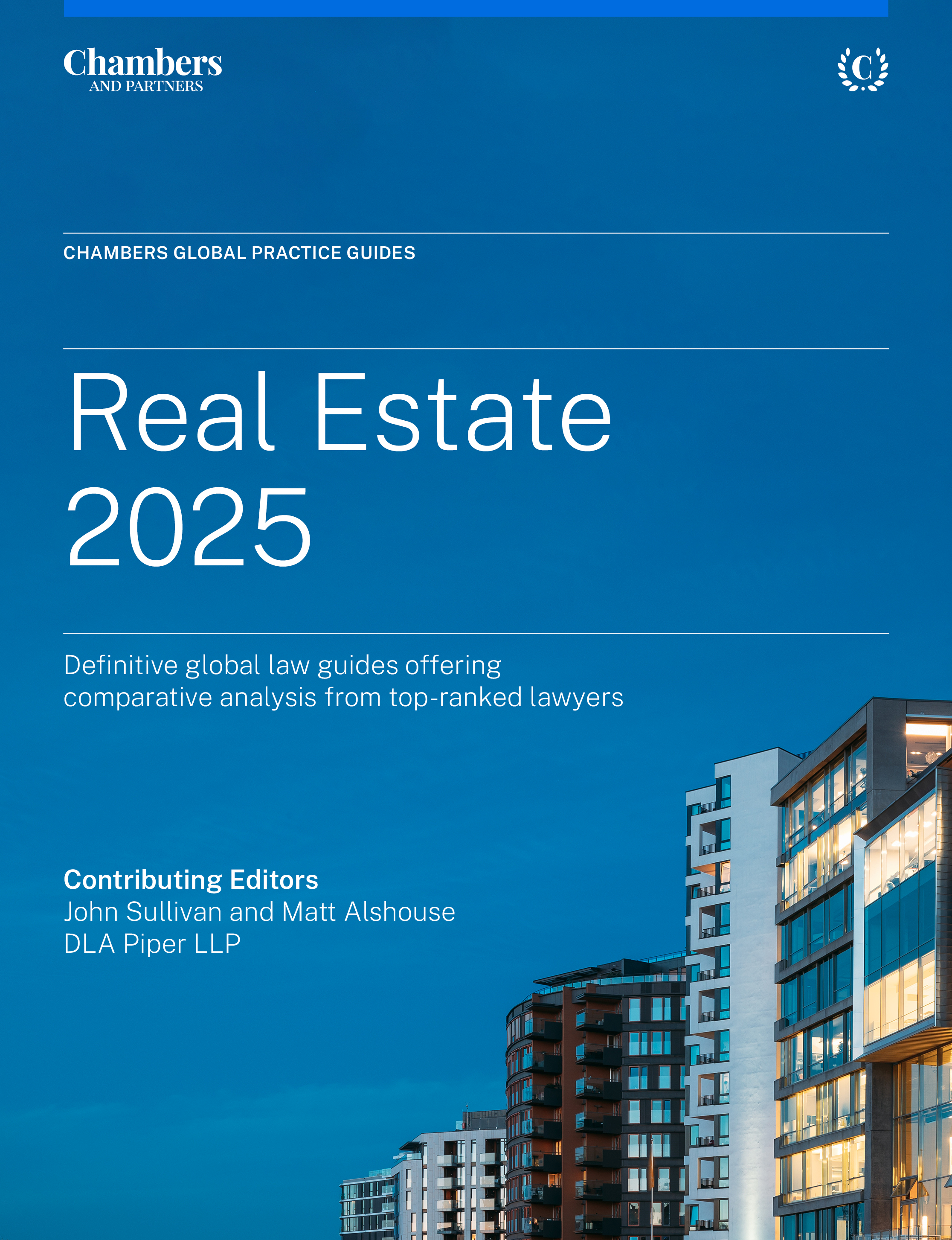
Real Estate 2025
The Real Estate 2025 guide features close to 50 jurisdictions. The guide provides the latest legal information on the impact of disruptive technologies, proposals for reform, sale and purchase, real estate finance, planning and zoning, investment vehicles, commercial leases, construction and tax.
Last Updated: May 08, 2025
Compare law and practice by selecting locations and topic(s)
Select Locations

Select Topic(s)

Please select at least one location and one topic to use the compare functionality.
Real Estate: A Global Introduction
Overview: high hopes to start the year, followed by uncertainty
As we have previously noted in this introduction, real estate is by far the world’s largest store of wealth, eclipsing the value of global equities and debt securities combined, and comprising almost four times global GDP. While the world’s population, and thus the need for the development and construction of real estate is ever growing, quite famously, no additional land can be produced. So, at a macro level, the future of global demand for real estate remains bright. Nonetheless, as readers of this guide know, macro forces can also disrupt the property markets.
One such macro force disruption was the COVID 19 global pandemic, which lead to a virtual freeze on real estate investment and lending activities, a general reduction in value across most asset types, an increase in loan and covenant defaults, and general stress and uncertainty. Just as the markets were starting to find a new equilibrium, COVID-era economic stimulus policies teamed up with pent up demand to bring us increased inflation and a dramatic upswing in interest rates. The result was another significant slowdown in real estate transactional activity as high inflation and interest rates stressed valuations and financing activities.
Following the challenges created by the pandemic, high inflation and rising rates, at the start of this year we appeared to be headed back into a more stable real estate landscape marked by higher transaction volumes. CBRE reports that 70% of the investors it surveyed in January of 2025 intended to buy more real estate in 2025 than in 2024, and close to half plan to sell more property, as well. PERE indicated similar feedback from institutional investors, noting that the proportion of their investor respondents seeking to reduce capital commitments to real estate markets declined to the lowest level since 2022. In other words, many are looking to turn the taps back on. After several years of muted transaction activity, this came as welcome news.
Now, however, recently announced tariffs and concerns about possible trade wars are creating new uncertainty both with respect to property markets and global markets generally. Whether the nascent tariff disputes continue, and what their effects on real estate might be, remains to be seen, but for the time being what was a fairly optimistic outlook for 2025 has been tempered.
2024 global trends and results
In the post-COVID inflationary landscape, central bankers aggressively raised interest rates in most major economic zones. The resulting increase in the cost of debt led to some unbridgeable bid ask spreads, as owners of property needed time to adjust to the lowered market value of their assets. These elevated interest rates also presented many property owners with a Hobson’s choice: sell their property now as long as they could get enough to repay their debt, or hold on in the hopes of a recovery, lower interest rates and/or the willingness of the lender to extend/restructure upon maturity. Much of the activity in global real estate markets over the course of 2022 and early 2023 centred around loan restructurings. MSCI Real Capital Analytics estimated that real estate sales decreased by 51% from 2022 to 2023, and the Urban Land Institute reported that global transaction activity within commercial real estate was lower in 2023 than in any year since 2012.
In the second half of 2024, the real estate markets benefited from the easing of interest rates. After raising interest rates to combat inflation nearly a dozen times between March, 2022 and July, 2023, leading to a 23-year high in rates, the US Federal Reserve made three consecutive rate cuts. The European Central Bank reduced rates four times in 2024. Other central banks reduced rates from their COVID-inflation fighting highs (with the exception of Japan, which had a negative interest rate for unique macroeconomic reasons going into last year and finally moved back into positive territory).
Although long-term interest rates did not necessarily fall as short term rates decreased, the easing of inflation and reduction in benchmark interest rates were welcome developments for the real estate market and, when combined with record amounts of capital available for investment and solid or improving fundamentals in many asset classes, the start of 2025 brought a general sense of optimism and a feeling that the adage “stay alive till 25” may have been prescient.
The results, at a macro level, are as follows.
I) Markets continued to find the bottom
The latter part of 2023 and 2024 saw some of the foreclosures, deed-in-lieu transactions and fire sales that were necessary to unclog the market. ATTOM, a leading property transactions data aggregator, noted that there were 625 commercial mortgage foreclosures in the United States in March 2024, the highest since 2014. By contrast, May 2020 saw just 141 commercial foreclosures. The Wall Street Journal reported in July of last year that over USD20 billion of retail, apartment and office loans had been foreclosed on in the United States in just the second quarter.
At the same time, deed-in-lieu turnovers and distressed sales increased in regularity. Many of the world’s largest real estate investors handed over the keys to over-leveraged properties. German commercial property values dropped another 5.4% in 2024, after a 10.2% plunge in 2023, according to the vdp (a German banking association). Promisingly, however, prices actually increased half a percentage point in the fourth quarter last year. These signs of the market bottoming out were seen across the globe, if not as dramatically.
II) Transactional volume increased across markets
By and large, investors got back to it in 2024. JLL reported that global investment volume in Q4 of 2024 was up by 37% year-over-year, and full-year activity reached USD704 billion, up almost USD90 billion from 2023.
Asian commercial property transactions last year were up by almost a quarter from 2023, to USD131 billion. As importantly, this increase in activity occurred across asset types, and across most markets. Office sector investment was strong, led by trades of multiple larger buildings in South Korea. Despite years of worry about the long-term prospects of retail property, volume was up more than a quarter in Asia in 2024, and Australian logistics properties were also a leading source of deals. Foreign investment in the Asian property markets was robust again, as well: cross-border investment volume in Asian reached USD23.8 billion in 2024, nearly doubling what was seen the prior year.
In Europe, a slow recovery has begun, focused primarily on the UK and southern markets with France and Germany lagging. In those latter two markets, according to Savills, investment volume in 2024 was still well under 50% of where it was in 2019, while investment in the UK was closer to 90% of pre-COVID figures. The consensus is that investors and lenders found the bottom of the market, particularly in London, much faster than in the continental markets.
In the United States, loan activity increased, leading to some stability returning to markets. CBRE’s lending momentum index was up 37% in the fourth quarter year-over-year, and entering 2025 was at levels not seen since late 2022. This was largely driven by traditional bank lenders and life insurance companies re-emerging and taking away some of the market share they had given up to alternative lenders in the prior few years. As a result of lending costs settling into relative stasis compared to the prior several years, cap rates fluctuated very little, as well, holding at 7% all year, indicating that both sellers and buyers were aligned on pricing fundamentals for the first time since 2019.
III) Geographic segmentation in asset classes
The recent trend of disparate sub-market trends continued across global markets in 2024. In Europe, for instance, logistics was the darling last year, with Cushman & Wakefield reporting price increases across 11 prime European markets in logistics properties in 2024. Office leasing prices also increased throughout the region, leading to positive pricing changes. A Savills investor sentiment survey from early this year identified big box logistics and urban logistics as the top two sectors for intended property investments in 2025, ahead of office, multifamily, hospitality, retail and every other asset class, an extraordinary finding.
In North America, data centres continue to lead the way, attracting an extraordinary amount of capital. From 2020 through 2022, the pre-leasing rate of under construction data centres in the United States hovered around 50%, meaning most development was on spec. In 2023 and 2024, however, about 80% of under construction data centre space had already been leased. Demand for this type of asset is only expected to grow, with the most important headwind to developers and investors being whether (and where) power supply and infrastructure can keep up. The United States is also seeing an increased focus on medical outpatient buildings (MOBs), both new construction and trades. Before the pandemic, vacancy rates in this sector were nearly identical to those in the office sector, but have diverged significantly. At the end of 2024, according to Nuveen, nearly 14% of US office space was unoccupied, compared with just over half that in MOB’s. In part, hybrid and work-from-home practices, which have lingered and become semi-permanent features of the American employment landscape, are to blame for the continued weakness in the office sector.
Not so in Asia. As noted above and in previous editions of this guide, the Asian office market has shown a resiliency lacking in Western markets, due to greater continuity in traditional working and occupancy expectations from employers. Asian development has also diverged from that of the rest of the world, as demographics (read: shrinking populations) have not led to the same acute demand for senior and student housing that has spurred investment in Europe and the Americas. Instead, as noted above, office uptake has remained strong through the struggles of the pandemic and its aftermath, and is expected to continue to attract a higher share of investor funding.
2025 outlook: high hopes, now tempered
As we entered 2025, there was a widespread consensus among market watchers and industry analysts that the upward trajectories seen in the latter stages of 2024 would continue, if not accelerate. With approximately USD600 billion of dry powder allocated for real estate at the end of last year, this was not a surprise. A Deloitte survey of commercial real estate holders showed that nearly nine in ten respondents expected increased revenue from property allocations this year, a remarkable turnaround from just a year prior, when six in ten anticipated losses. This sunnier outlook was also based on solid GDP growth throughout most of the globe, and predictions of more interest rate cuts as economies stabilised. It is worth noting that, even with central bank monetary easing beginning in earnest last year, kick-starting the markets, only about 20% of the prior two years’ rate increases have been reversed to date globally. Investors see a present landscape with more attractive debt pricing, but also a future with even lower borrowing costs as there is more than adequate room for continued central bank rate cuts. This gives investors the ability to see values increasing in coming years, rather than a future of struggling to refinance properties or sell to buyers who cannot make pricing models work due to the high cost of debt.
In the aggregate, Savills projected toward the end of last year that global real estate investment would eclipse USD950 billion this year, a substantial increase over 2024 (which, of course, saw significantly more activity than 2023).
Regionally, CBRE’s APAC market outlook for this year included an investment volume increase of 5-10%, resulting from growth centred in the Korean, Australian and Singaporean markets, and to a lesser degree, Japan and India. Its regional investor intent survey indicated that continued interest rate cuts and better asset prices had more than doubled net purchasing intentions from a year prior, with steady growth expected to be led by strong office lease uptake and improved retail rental activity.
In Europe, there was widespread anticipation of continued growth in logistics space, with CBRE projecting that demand for sector space would be increasing by around 12.5% on average throughout the region, led by a short term need for over 20% more square footage than currently exists in Spain.
Not surprisingly, data centres were again seen as driving the entire US commercial real estate market forward, along with renewed optimism around continued interest rate improvements and lower vacancy levels. This is not just a US phenomenon, of course: JLL’s global real estate outlook from last December projected another nearly 20% increase in new inventory coming online around the world this year, which still does not come near to satisfying user demand.
Potential limiting factors: the maturity wall, climate change and US immigration concerns
Views are not entirely rosy, of course. There are a number of factors with the potential to limit growth in market activity and prices in 2025. Although we have climbed over the peak of the so-called “maturity wall” there is still loan maturity risk in the markets as we head down the other side. In the United States, for instance, upwards of 30% of the office loans maturing this year are collateralised by properties valued at less than loan principal.
Continuing concerns about the impacts of climate change are also a drag on market optimism. Long-term prognostications about where populations will want to live have become more difficult, making development decisions complicated. There are also short-term impacts, with extreme weather events happening more and more frequently. Intermittent supply disruptions, questions about whether certain locations are becoming less and less attractive, and, more immediately impactful in real estate markets, skyrocketing insurance costs. According to Deloitte, average commercial property insurance premiums have nearly doubled in the last decade, and are predicted to increase by almost 9% per year through at least 2030. In extreme weather areas, these increases will be even higher and some markets may even see a complete lack of third-party insurers in the foreseeable future.
In the United States, it remains to be seen whether inflationary pressures from restrictive immigration policy, and aggressive deportation activity, materialise, and whether those pressures hamper real estate markets. At a minimum, it could lead to relevant labour shortages and construction cost increases. Most experts have concerns over restaurant and agricultural operations viability, which could of course have secondary effects on property markets.
Conclusion
As the calendar turned from 2024 to 2025, there was a general sense of optimism in the real estate sector. Inflation appeared to be cooling, interest rates had reduced from their post-COVID peaks, and there were record amounts of available investment capital. Transaction flow had started to pick up and lenders were becoming more active. Construction was beginning to pick up steam.
The recently announced tariffs have, however, injected uncertainty into the picture. TheEconomic Policy Uncertainty website, a joint project of researchers at the University of Chicago, Northwestern, and Stanford, has a series of Economic Policy Uncertainty Indexes, showing economic policy uncertainty for various countries. In February 2025, the US index hit 334.51. Going back to 1985, that is the highest level outside the worst of the pandemic.
Although the long-term impacts of the recently announced tariffs are difficult to predict, many investors, developers, lenders and other market participants are pausing – or at least slowing down – their new investment and capital improvement activities until there is more clarity.

